There are a number of timely activities on the allotment that I enjoy, but planting out the new season garlic is probably my favourite gardening ritual of the year.
It’s been a while since I wrote a hefty piece on the blog. However, garlic and specifically growing your own garlic is definitely a topic I feel needs to be talked about.
I love growing garlic. I love eating garlic. I love the experience of planting the new garlic in autumn when the garden is sufficiently calm and the busyness of the preceding season has died away. Popping the cloves into the ground is one of the rare opportunities at this time of year to get the fingers in the soil and plant something that is just bursting to get started as we move into the colder season.
I really want to encourage everyone to grow their own garlic in all its incredible variety and enjoy eating more of this brilliant bulb.
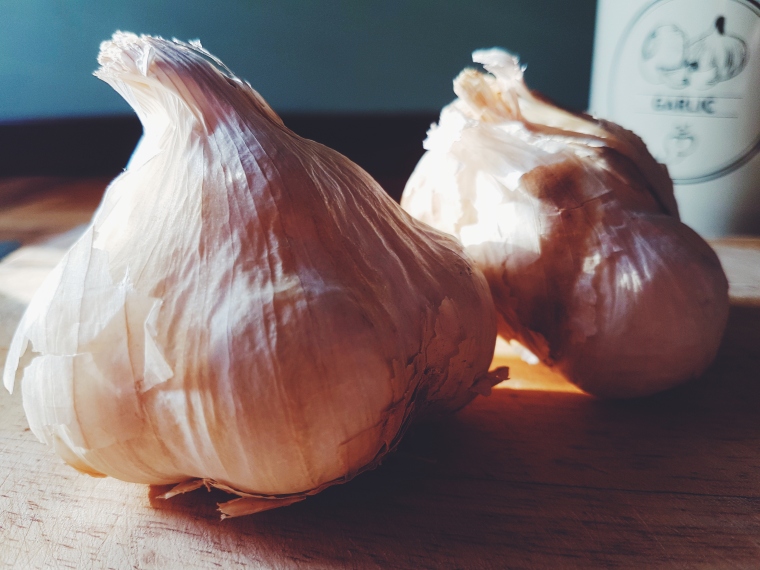
(Note: There are some affiliate links in this post, which means you can click on them to buy. If you do, I may get a small fee. It doesn’t affect the price you pay.)
In 1977, Natasha Edwards was just a toddler when her father planted his first crop of garlic on a farm on the Isle of Wight. Now, that farm grows over 20 varieties of garlic over 60 acres. This place is traditionally called Mersley Farm, but most people know it as The Garlic Farm.
Natasha has written a book all about this fantastic plant. Having grown up with this experience of planting, nurturing and growing what is now an incredible amount of garlic, I can’t imagine anyone better to write a book about it.
The book is not only a fascinating resource about garlic, it oozes with Natasha’s passion of a bulb she knows so intimately. I for one, with an existing appetite for garlic, have taken so much from reading her text.
Amazon
£18.96
A very brief history of garlic
Thirty or forty years ago, garlic would have been a foreign sight in kitchens across the country and an even less common spectacle growing on allotments and in kitchen gardens.
Garlic’s indigenous habitat – its beginnings – is central Asia. And this pungent, savoury crop has been on an incredible journey and through a phenomenal history.
There is a fascinating section in Garlic: The Mighty Bulb: Cooking, Growing and Healing with Garlic that illustrates the origins of garlic and its journey over time and across the continents of the world.
This journey begins at the end of the last ice age around 10,000 BC. Through the melting snows of spring, Allium longicuspis – the ancestor to wild garlic – appeared in small areas along the Tien Shan mountains where small nomad groups carried the crop out of the area and so begins garlic’s cultivation.
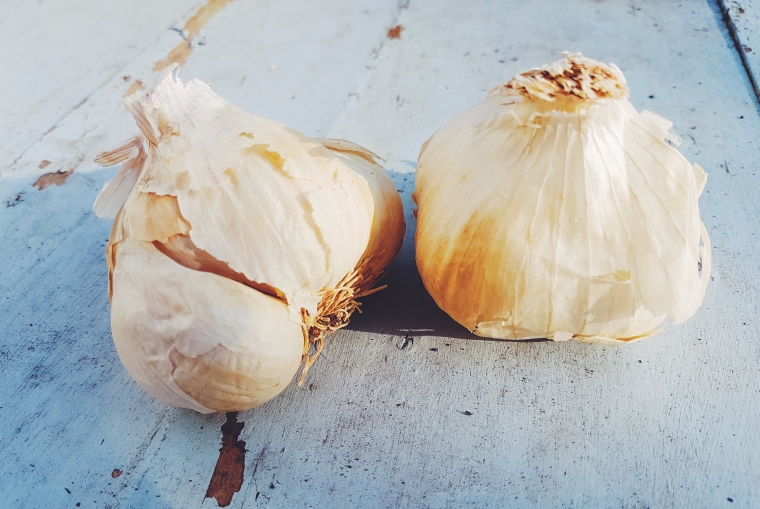
I might be close to sharing the perspective of garlic held by the ancient Egyptians. They worshipped it. In 3,000 BC the bulb is held in high acclaim by this population who regard it as a provision of great health and well-being. So much so, archaeologists have discovered clay sculptures of garlic buried in the tombs of their dead.
In 500 BC the mighty bulb gets a mention in Ancient Greek literature and their medicinal texts and in 42 AD, Garlic finally arrives on the shores of Great Britain with the Norman Conquest.
After travelling to the Americas in 1500 AD with the Spanish, the first production of garlic takes place in California in 1880. It’s not until 1975, in the hands of Natasha Edwards’ father, that garlic is grown on the Isle of Wight at what we now call The Garlic Farm.
Garlic varieties
There are hundreds of varieties of garlic, all offering different size, shape, colour and most importantly, flavour.
Supermarkets don’t allow us to experience this as they rarely stock more than one kind of garlic.
If you explore farmers markets you will begin to see a new world of garlic open up to you and if you grow your own garlic, then this incredible new world can be as close as your very own back garden or allotment.
All garlic can basically be divided into two types: Hardnecks and Softnecks.
Hardneck garlic develops a stiff flower stalk known as a scape as it grows. This scape should be removed to ensure the bulb develops to its maximum size. The scape is edible though, so don’t waste it. They are delicious chopped up into a salad or sauteed in butter. Hardnecks are more winter-hardy than softneck varieties and are therefore great for growing in northern climates. The key benefit of growing hardneck varieties is for the immense flavour.
Softneck garlic does not usually develop a flower stalk. They thrive in warmer climates and mild winters. They have a milder flavour in comparison to hardneck varieties and they possess a good storing quality. These are typically the variety of garlic found in supermarkets.
Elephant Garlic is a fantastic crop to grow for the kitchen. The hulking great bulbs are not true garlic and are more closely related to leeks. They have a mild flavour and the best (and in my view, only) way to use them is to roast them whole and serve the soft pulp with strong cheese and good bread.
What am I growing this year?
This year, I’ve picked one hardneck and one softneck to grow on our allotment.
I discovered the wonderful benefit of growing hardneck types last year. If you love garlic and really want to experience the flavour it can offer, then hardnecks simply knock to socks off softneck varieties. They might not provide the super storage capacity of the softnecks (and this is clearly a benefit of growing both) but with the taste they offer, you will want to use them often and quickly anyway.
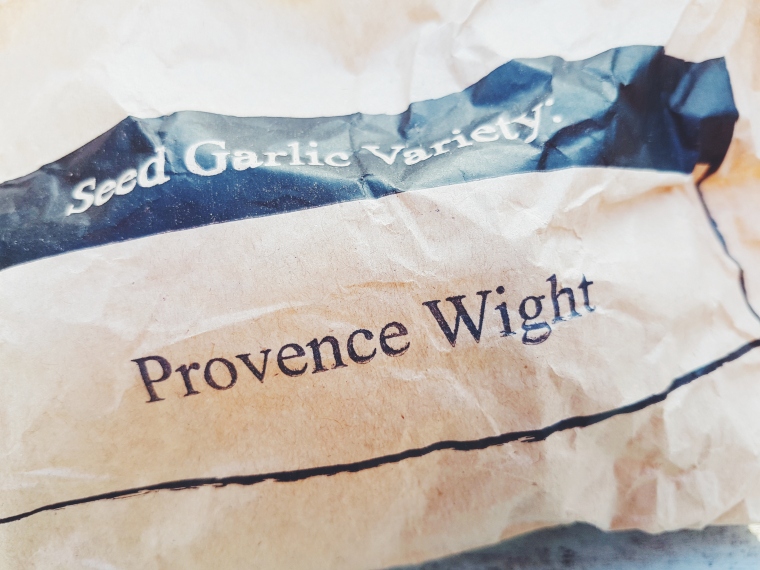
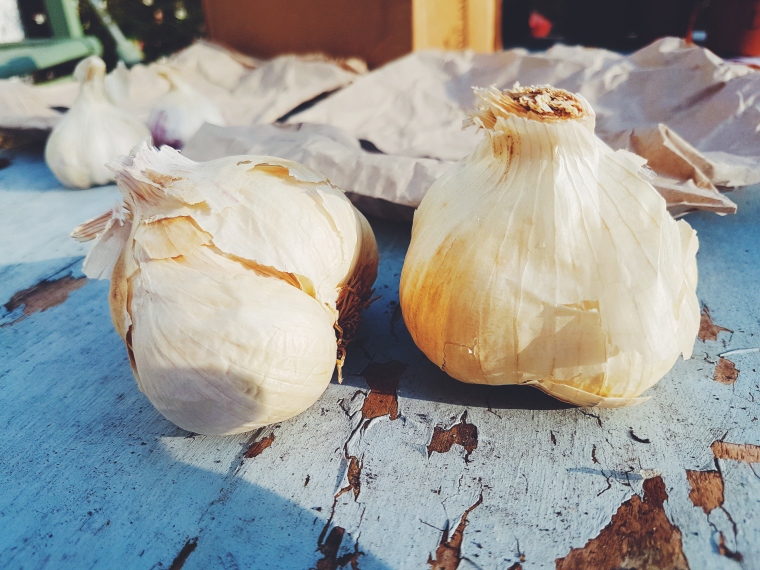
Provence Wight is a large white softneck variety which originates from the valleys of the Drôme in the north of Provence. It produces large, plump cloves with a warm subtle flavour and as is typical of softneck varieties, it offers a good storage quality.
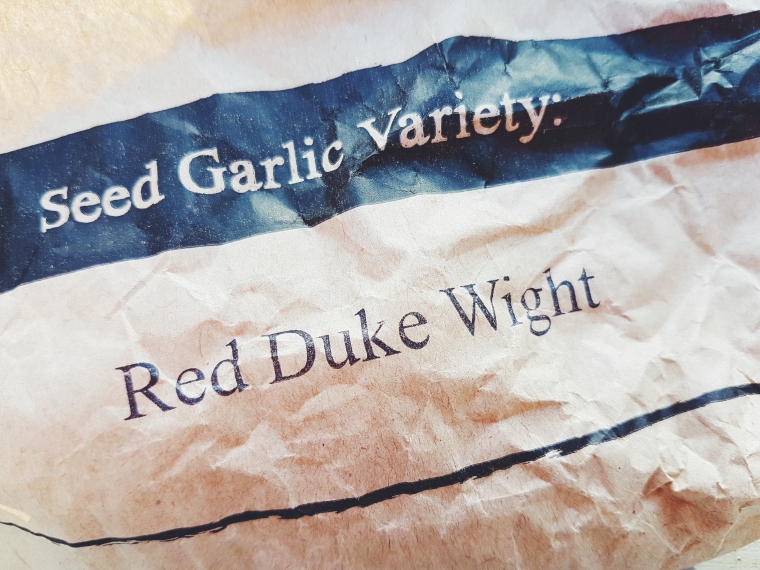
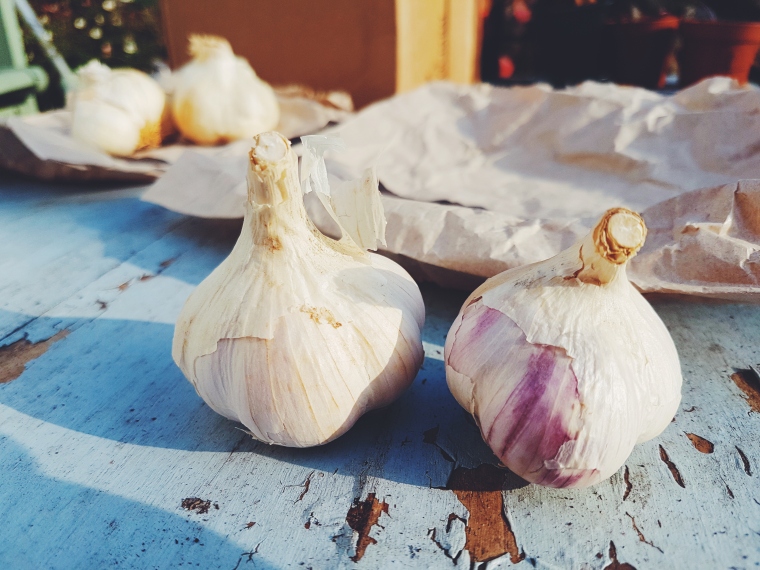
Red Duke is heritage, purple clove, hardneck variety. Why this one? Just read the description from The Garlic Farm:
The last stronghold of rare exotic hardnecks with fierce and spicy flavours is in Eastern Europe. Hotter and stronger than any of the commonly planted garlic in the UK, these bulbs still have the attributes of their mother bulbs which came from Central Asia, perhaps 800 years ago with the Mongol invasions. Bright white skins with plump purple cloves.
My tongue is dancing in my mouth!
Growing garlic
Garlic is one of the most used ingredients in our kitchen and it’s probably the most reliable crop I grow. It grows very well in our northerly climate but it needs a long season to establish large bulbs and well-determined cloves.
I plant our garlic out in the middle of October. I have planted garlic in late December before and there was a noticeable difference in the size of the bulbs I harvested the following summer compared to those that had gone into the ground in October.
At the very least, aim to get your garlic into the ground a few weeks before the ground freezes. In the UK, with its tendency for mild, wet winters, it’s likely this might not happen until well into the winter, if at all, but as a general rule, plant your garlic in the middle of autumn. You will, in but the worse of years, get a good crop.
Preparation
Garlic is very easy to grow, but there are some basic considerations for it to thrive and produce a good crop. It needs good soil and so in preparation for planting garlic, make sure you incorporate or what I prefer to do, mulch the bed with as much organic matter as possible before planting in the autumn. Last year, I grew our garlic on one of my no-dig trial beds. I layered the top of the soil with a large helping of compost and planted the garlic cloves directly into it. We had a fantastic crop.
Garlic thrives in a sunny position and in free draining soil. Pick your planting location with these in mind.
Garlic is also a great companion to so many other crops that suffer from pests such as aphids and other destructive bugs. So take the opportunity to plant garlic next to them. The odour is enough to put these critters off or at least confuse them in finding their favourite dinners.
Wait until you are ready to pop the cloves into the soil before you split the seed bulb. Plant the cloves an inch below the surface of the soil and space them six inches apart. I prefer to use a trowel to open the soil for the clove rather than pushing it directly into the ground. The roots are fragile and this alleviates the risk of any potential damage before the garlic has even got started.
If you get the fundamentals right, the only maintenance is to keep the garlic crop weed free.
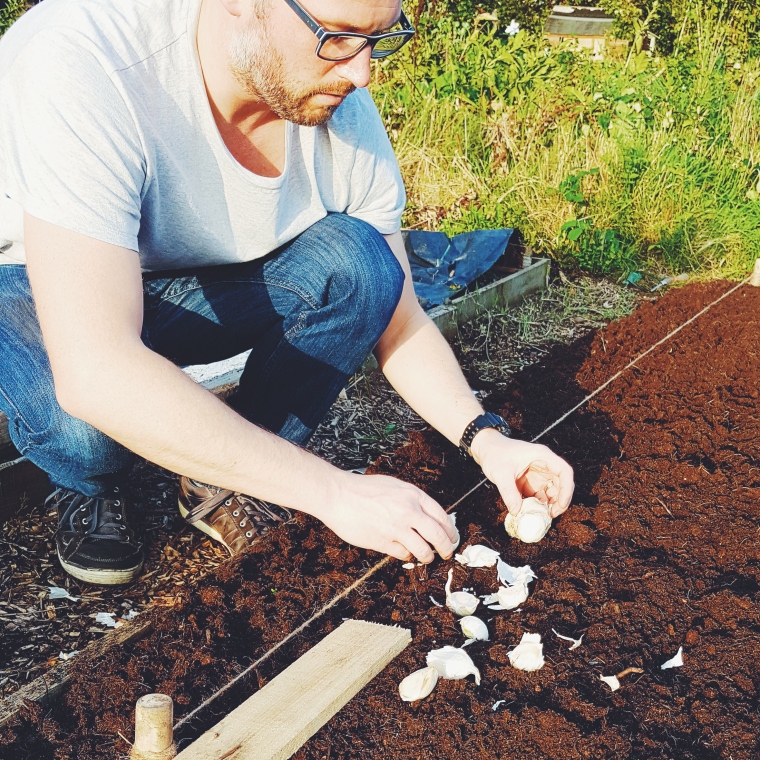
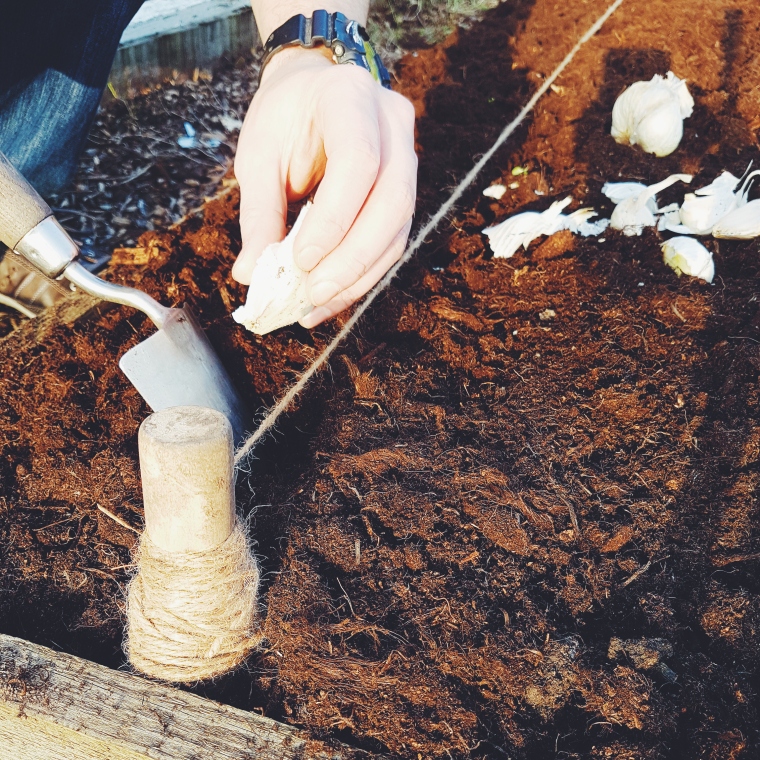
Growing garlic in pots
If you don’t have an allotment or a lot of space in the garden, garlic can be grown in pots. You need a container that is at least 6 inches deep and has excellent drainage and make sure it’s big enough to provide for 6 inches of space between cloves too. You might like to use a few containers to ensure the garlic has the required growing space.
Harvesting
There is such pleasure to be had when after a long growing season, the garlic bulbs are revealed for the first time in late summer. After a significant period of waiting and not knowing what lies beneath the surface of the soil, it’s a magical experience to reveal these plump, white bulbs from the ground.
Wait until the lowest most leaves of the garlic have turned yellow and died off. If your ground is pretty loose, you can get away with simply pulling the bulbs out of the soil. If the soil is firm, then use a fork to get underneath the bulb and lever the bulb out.
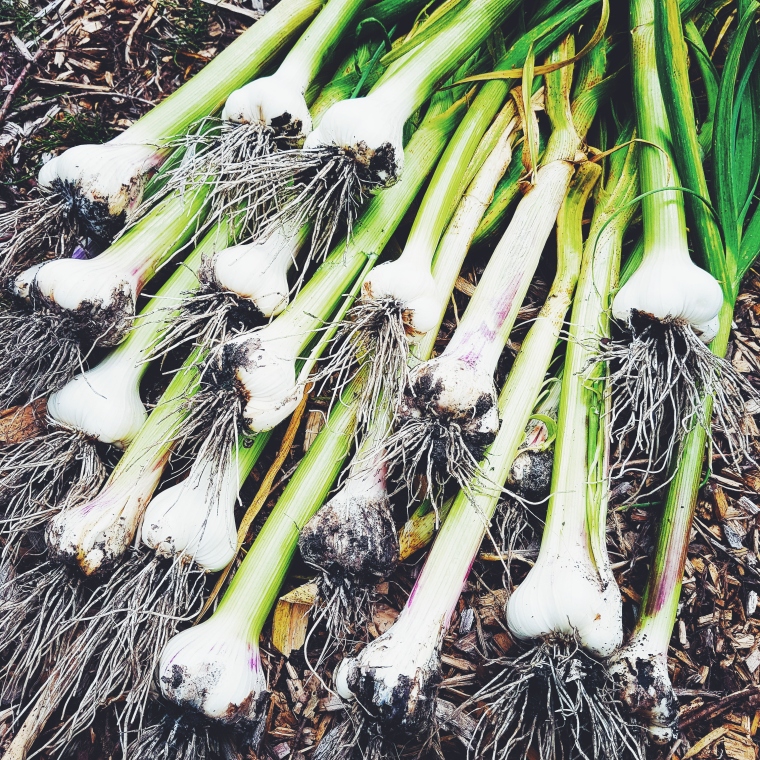
I pull away the first layer of ‘skin’ from the bulb. It leaves you with a very clean bulb to start with before you lay them out to dry. And if you want to store your garlic for any significant amount of time, you need to let the bulbs dry. This period of maturity also allows the flavour to develop depth.
Phew! I really love this crop. Right, I’m off to raid the garlic tin…
If you’ve not grown your own garlic, I really hope this post has whet your appetite to give it go this year. Let me know. If you are already a garlic growing aficionado, I’d love to hear from you in the comments below. What varieties would you recommend to other growers?
Follow Sharpen Your Spades! You can receive my post by email by subscribing to the blog (Right or Below) or you can follow me on BlogLovin.
You can get in touch with me here.

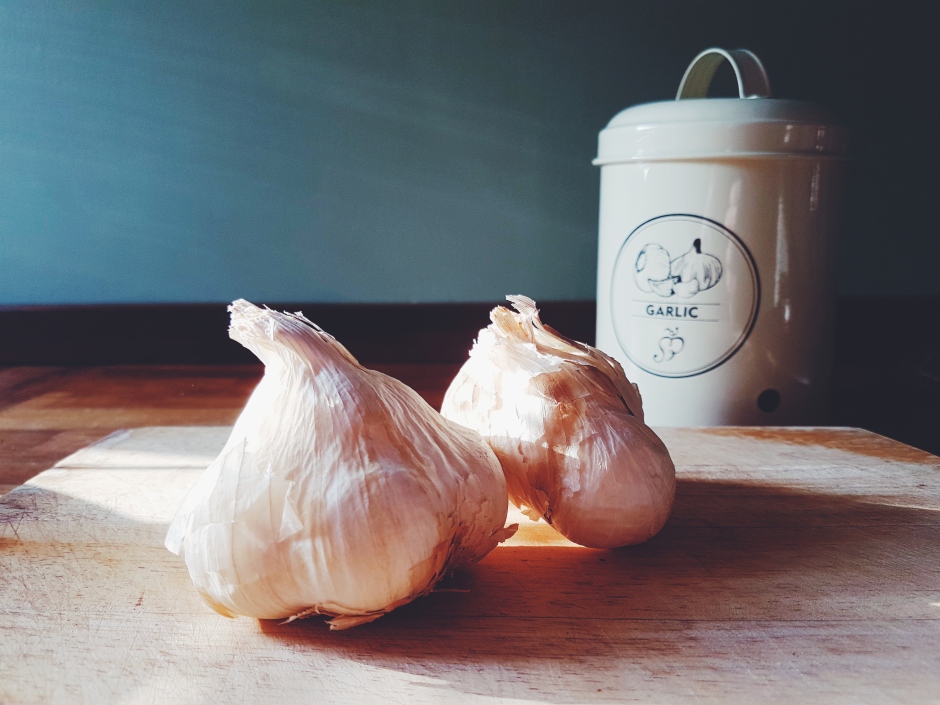


Great post, I really enjoyed reading about garlic’s long history. I grew Red Duke last year, it was lovely and very low maintenance. Great idea to grow more than one variety too – you can have a bit of a taste-off!
LikeLiked by 1 person
Hi Catherine. Thanks so much. It’s funny how much comes out when it’s a topic you really enjoy. I’d grow more than two if I’m honest. I’m trying to be good this year. Probably grow some elephant garlic too. Glad to hear that about Red Duke.
LikeLike
Hi Richard, I enjoyed reading the post. It’s made me think I should be trying more varieties of garlic. I’ve just planted San Marco, but perhaps should find room for a second. I confess I don’t even know if San Marco is hardneck or softneck! And there’s my dilemma, as i am not as keen on the stronger garlic as you seem to be! I suspect the hardnecks might give me larger returns given the climate, but I might prefer the milder softneck types for flavour. Let me know if you can suggest a mild hardneck variety. I’ve grown a few garlics before and do recommend it for people starting to grow their own, it’s so easy! It was one of the first crops I learned to grow, and in the ground or in pots, I love that you can just drop it in and almost leave it to its own devices until the summer.
LikeLiked by 1 person
Hi Paul. Thanks for dropping by. Really pleased you enjoyed the post. I think Marco is a softneck. I’ve only grown a few hardnecks as I must admit I only really discovered them a year or so ago. I’ll be trying different ones on the plot each year. You might like to try Lautrec Wight. It’s on my list as it’s highly rated French variety. It’s described as strong but with a smooth taste. And I completely agree. Garlic is such an easy crop to grow. It’s one of the reasons I enjoy growing it so much.
LikeLike
Hi Richard. Thanks for the great post on garlic. It was the first thing we grew on our allotment because we got our plot in the winter. I think that’s why I have a soft spot for garlic too. The small crop also lasted nearly a year as you use so little of it when you cook. Definitely one that I recommend to anyone starting out with an allotment.
LikeLiked by 1 person